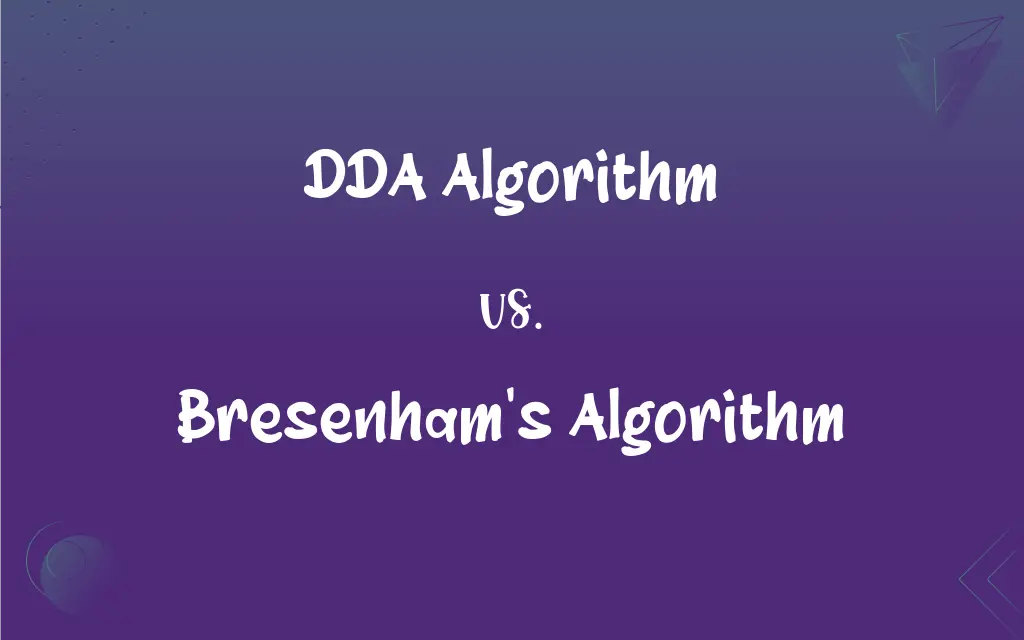DDA Algorithm vs. Bresenham’s Algorithm: What's the Difference?
Edited by Aimie Carlson || By Janet White || Published on February 29, 2024
DDA Algorithm incrementally plots points of a line using floating-point operations, while Bresenham's Algorithm uses integer operations for rasterizing lines, being more efficient.

Key Differences
The DDA (Digital Differential Analyzer) Algorithm is used for rasterizing lines and involves floating-point calculations, which can be computationally intensive. In contrast, Bresenham’s Algorithm uses integer calculations, making it more efficient and suitable for computer graphics where processing speed is crucial.
DDA Algorithm incrementally plots points along a line based on slope calculations, potentially leading to rounding errors and less sharpness in the rendered line. Bresenham’s Algorithm, however, minimizes these rounding errors by using an efficient incremental error update method, resulting in more accurate and visually appealing lines.
When it comes to handling shallow or steep lines, the DDA Algorithm may require adjustments for different slopes, as it handles x and y increments separately. Bresenham’s Algorithm naturally adapts to varying slopes without needing special adjustments, offering better uniformity in line drawing.
In terms of simplicity, the DDA Algorithm is conceptually straightforward and easier to understand, which makes it useful for educational purposes. Bresenham’s Algorithm, while more complex due to its optimization techniques, is preferred in practical applications for its speed and accuracy.
DDA Algorithm tends to produce lines with varying brightness, which may not be uniform due to the use of floating-point arithmetic. Bresenham’s Algorithm maintains consistency in brightness and thickness, providing better quality for digital graphics.
ADVERTISEMENT
Comparison Chart
Calculation Type
Floating-point
Integer
Computational Efficiency
Less efficient
More efficient
Rounding Errors
More prone to errors
Minimal rounding errors
Adaptability to Slopes
Requires adjustments
Automatically adapts
Line Quality
Less uniform, varying brightness
Consistent, uniform lines
ADVERTISEMENT
DDA Algorithm and Bresenham's Algorithm Definitions
DDA Algorithm
An algorithm for rasterizing lines using floating-point arithmetic.
The DDA Algorithm was used to draw smooth curves in the graphics project.
Bresenham's Algorithm
Preferred for uniform line quality in raster displays.
Bresenham’s Algorithm ensured consistent line thickness in the architectural visualization tool.
DDA Algorithm
A linear interpolation method for digital differential analysis.
He chose the DDA Algorithm for its conceptual ease in his first computer graphics assignment.
Bresenham's Algorithm
A method that minimizes rounding errors in digital line generation.
The crisp lines in the design were a result of Bresenham’s Algorithm.
DDA Algorithm
Utilizes successive addition to plot points along a line.
The DDA Algorithm was implemented for its straightforward approach in the educational software.
Bresenham's Algorithm
Optimized for better performance in computer graphics applications.
The graphic software's efficiency was greatly improved after integrating Bresenham’s Algorithm.
DDA Algorithm
A line generation method based on incremental calculations.
For the simple line drawing task, the DDA Algorithm proved sufficient.
Bresenham's Algorithm
An efficient line drawing algorithm using integer calculations.
Bresenham’s Algorithm was chosen for the game’s rendering engine for its speed.
DDA Algorithm
A graphics algorithm where each step involves a floating-point operation.
The DDA Algorithm was initially used but later replaced by a more efficient method in the simulation.
Bresenham's Algorithm
Utilizes incremental error calculation for rasterizing straight lines.
For the high-resolution graphics, Bresenham’s Algorithm provided the necessary precision.
FAQs
What are the drawbacks of the DDA Algorithm?
It's prone to rounding errors and less uniform line quality.
Why is Bresenham’s Algorithm preferred in graphics?
Due to its efficiency and minimal rounding errors.
Is DDA Algorithm efficient for modern graphics?
It's less efficient compared to integer-based methods.
Can Bresenham’s Algorithm draw circles?
Yes, with modifications, it can draw circles and other shapes.
Is Bresenham’s Algorithm suitable for all line angles?
Yes, it handles varying line slopes efficiently.
What is the DDA Algorithm?
A line rasterization method using floating-point arithmetic.
What makes Bresenham’s Algorithm accurate?
Its incremental error calculation enhances accuracy.
How does DDA Algorithm compare to Bresenham’s in terms of speed?
Bresenham’s is generally faster and more efficient.
Can DDA Algorithm handle steep lines well?
It can, but may require additional adjustments.
Is the DDA Algorithm easy to implement?
Yes, its conceptual simplicity makes it easy to implement.
Does DDA Algorithm require a powerful processor?
It's more demanding due to floating-point calculations.
Can DDA Algorithm be used in 3D graphics?
Yes, but it's not typically preferred due to efficiency concerns.
Can Bresenham’s Algorithm be used on all types of displays?
Yes, it's versatile across different raster display technologies.
What programming languages can implement DDA Algorithm?
It can be implemented in most languages, including C++, Java, and Python.
What is Bresenham’s Algorithm?
An efficient line drawing algorithm using integer operations.
Does Bresenham’s Algorithm work on non-linear paths?
It's primarily designed for straight lines, but can be adapted.
How does Bresenham’s Algorithm benefit real-time rendering?
Its speed and accuracy make it ideal for real-time applications.
Is anti-aliasing possible with DDA Algorithm?
Yes, but it may not be as effective as with other methods.
Are there any variants of the DDA Algorithm?
Yes, there are modified versions for specific applications.
Is Bresenham’s Algorithm suitable for beginners in graphics programming?
Yes, although it's more complex than DDA, it's a fundamental algorithm in graphics.
About Author
Written by
Janet WhiteJanet White has been an esteemed writer and blogger for Difference Wiki. Holding a Master's degree in Science and Medical Journalism from the prestigious Boston University, she has consistently demonstrated her expertise and passion for her field. When she's not immersed in her work, Janet relishes her time exercising, delving into a good book, and cherishing moments with friends and family.
Edited by
Aimie CarlsonAimie Carlson, holding a master's degree in English literature, is a fervent English language enthusiast. She lends her writing talents to Difference Wiki, a prominent website that specializes in comparisons, offering readers insightful analyses that both captivate and inform.
































































